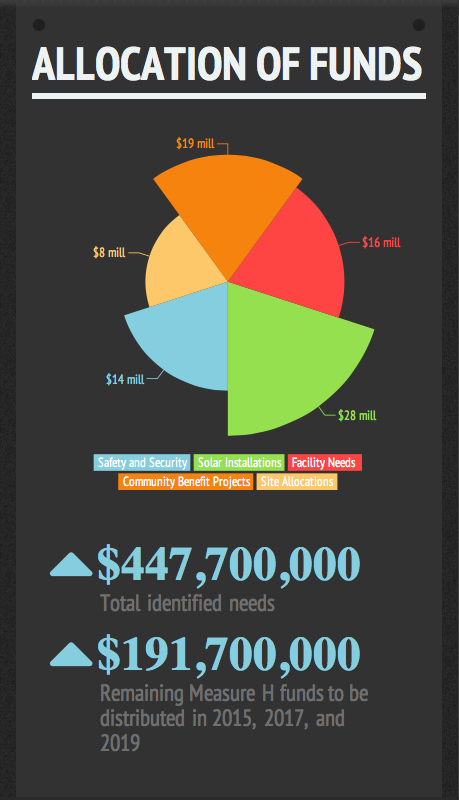Measure H: Bringing Out the Big Funds
December 19, 2014
$191.7 million dollars. That is the sum that will be available for district use as a result of the approval of Measure H, which appeared on the ballot in 2012. With so many schools in dire need of funds, most people were relieved to hear that some of their monetary problems would soon be solved. However, with a grand total of $485 million dollars in identified needs, it is safe to say that the funds will be spread thin. $191.7 million dollars is a lot of money, but it’s nowhere near enough to fix the district’s problems.
Since the passage of the measure, funds have been collected and will begin to be distributed in January of 2015. The funds will be distributed every two years, 2015, 2017, and 2019 respectively. Consequently, only $85 million will actually be available for use in 2015.
The funds will be distributed into five categories: community benefit projects, solar installations, site allocations, facility needs, and safety and security.
Have you ever wondered why a performing arts focused school does not have access to a communal theater? Do you think that having an aquatic center would benefit our athletes? Well, community benefit projects will focus on two possible options, these include a performing arts center and an aquatic center. $19 million dollars out of the $85 million are reserved for this project, however a final decision on whether one or both projects will be funded will not be made until the end of 2015 or January of 2016 at the latest.
A Blue Ribbon Panel will present to the Board of Education with research regarding the project towards the end of January 15. The panel members must first determine that there is an appropriate location for the project; that it will be a viable, long term project; that the facility can be maintained; and that the facility can be used properly before making their final recommendations. If neither project is approved by the board, the money will go towards the facility needs category.
The Blue Ribbon Panel has nearly twice as many representatives for the performing arts center than it does for the aquatic center. McMahon explained that this imbalance is due to the significance of each project. The Board estimates that an aquatic center would cost $4 million dollars to construct, whereas a performing arts center would cost approximately $15 million dollars. “Given the scale of the potential investment, we wanted to ensure that there was representation regarding that larger investment,” said Chief Business Officer of Administrative Services, Stephen McMahon. He later mentioned that “the performing arts center needs to have all of the high schools involved because the needs might not be as consistent as the aquatic center’s potentially would be.”
This project could definitely benefit Lincoln, as nearly half of the student body is involved in performing arts at Lincoln High. The School Board encourages students to voice their opinions about the projects, as McMahon said in a recent Board meeting that “[their actions] are driven by community feedback.”
Contrary to popular belief, the solar panels that provide shade for the cars in the parking lot are owned by Bank of America, rather than the district. This is costly, as it requires the district to pay a large fee that goes towards purchasing the solar installations. The contract with Bank of America will expire by 2029, at which point the district is given the option to purchase the installations or to have them torn out. Prior to that, however, the contract allows the district to implement a one-time buy out in January 2015. The Board plans to dedicate $28 million dollars from Measure H funds to take advantage of this buy out, as McMahon says “it would be cheaper to own [the solar panels] now than at the end of the contractual term.” This will save the district millions of dollars and give the district ownership of the solar panels.
Along with all the aforementioned projects, Measure H provides funds for individual projects to be determined by each school. $8 million dollars are reserved for site allocations, with schools receiving $250 dollars per student. Throughout the district, Lincoln will be receiving the most funding, as it is the most populated school. This money can be used for any general purpose such as shade structures and additions to already funded projects as long as the school gets the approval of the School Site Council and goes through the Capital Improvement Project Process before proceeding.
Among the most basic projects that will receive funding are facility needs. $16 million dollars have been set aside for general school improvement projects such as modernization, energy efficiency, and new construction. The distribution of these funds will be based on the degree of need of each school, as determined by the facility staff. The paramount needs will be addressed first, and any remaining money will go to secondary needs.
Lastly, $14 million dollars will go towards maintaining the safety and security of the district’s many campuses. These safety and security projects include door locks, perimeter access, and surveillance systems. The safety and security projects will be addressed before all other categories. McMahon said that the aforementioned projects will be “expedited to the implementation phase” because “the safety and security of students, staff, families, and community members at large is paramount to the district.”
At the School Board meeting on Nov. 20th, Board Vice President Teresa Castellanos had some final words for the members of the SJUSD community about the Measure H allocations: “I know it’s hard, and I know that we have double the need and double the requests and half of the funding…I know that we’re not going to meet every need, every hope, and every dream because it’s not [really possible]… I think we’re in a place in the state of California where we are not investing in public education. We’re going to do the best we can under the conditions we have, but I can’t commit to making everyone happy. I encourage all of us to be speaking to our state officials and saying [they] need to invest more because our schools are falling apart…Realistically, we are not investing sufficiently in what we need for the future or even the present.”

